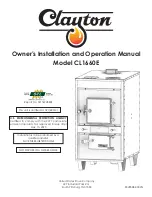
SYSTEM OPERATION
15
VENT/FLUE TEE (
or
45° ELBOW
TURNED DOWN or
90° ELBOW TURNED
DOWN
OPTIONAL)
12" MIN. ABOVE
HIGHEST ANTICIPATED
SNOW LEVEL
12" MIN.
Horizontal Termination (Single Pipe)
Above Highest Anticipated Snow Level
10”- 24”
90º OR 45°
ELBOW
12" MIN. TO GRADE OR
HIGHEST ANTICIPATED
SNOW LEVEL
6” MAX
4” MIN
Standard Horizontal Terminations (Dual Pipe)
90°
ELBOWS
12" MIN. ABOVE
HIGHEST ANTICIPATED
SNOW LEVEL
3” - 24”
Alternate Horizontal Vent Termination (Dual Pipe)
90°
ELBOWS
12" MIN. ABOVE
HIGHEST ANTICIPATED
SNOW LEVEL
3”-24” BETWEEN PIPES
Combustion Air Intake may also be snorkeled to obtain 12” min
ground clearance
.
Alternate Vent Termination Above Anticipated Snow Level
(Dual Pipe)
12" MINIMUM
VENT/FLUE TEE
OR
90° ELBOW TURNED
DOWN
12" MINIMUM ABOVE
HIGHEST ANTICIPATED
SNOW LEVEL
90% Furnace Horizontal Termination (Single Pipe)
Above Highest Anticipated Snow Level
In a basement installation, the vent/flue pipe can be run be
-
tween joist spaces. If the vent pipe must go below a joist and
then up into the last joist space to penetrate the header, two
45° elbows should be used to reach the header rather than
two 90° elbows.
Direct Vent (Dual Pipe) Piping
Direct vent
installations require both a combustion air intake
and a vent/flue pipe. The pipes may be run horizontally and
exit through the side of the building or run vertically and
exit through the roof of the building. The pipes may be run
through an existing
unused
chimney; however, they must
extend a minimum of 12 inches above the top of the chim-
ney. The space between the pipes and the chimney must
be closed with a weather tight, corrosion resistant flashing.
Both the combustion air intake and a vent/flue pipe termina
-
tions must be in the same atmospheric pressure zone. Refer
to
Vent/Flue and Combustion Air Pipe - Termination Loca-
tions or Concentric Vent Termination
section in this manual
or the installation instructions for specific details on termina
-
tion construction.










































